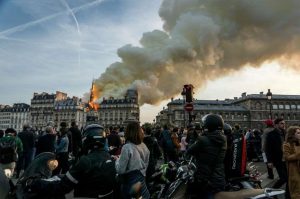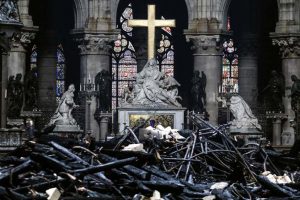APRIL 16, 2019

PARIS — A day after a monstrous fire roared through Notre-Dame cathedral, destroying its roof and lacy spire and leaving three holes in its sweeping vaulted ceiling, officials on Tuesday were trying to determine what caused the catastrophe.
The cathedral appeared to be structurally sound, officials said, after an inspection. With the fire extinguished, they now began what the Paris prosecutor, Rémy Heitz, told journalists would be “a long and complex investigation,” though for now he said they were considering the disaster an accident.
“Nothing at this stage suggests a voluntary act,” he said.
The Paris prosecutor’s office said on Tuesday evening that investigators had questioned about 30 witnesses so far. These included workers from the companies involved in the restoration of the cathedral not long before the fire broke out, and staff at Notre-Dame in charge of security.
A spokesman for the cathedral said it would take at least 48 hours before the building was safe to enter.
The first fire alarm on Monday was set off at 6:20 p.m., and checks were carried out but no fire was found, Mr. Heitz said.
A second alarm went off at 6:43 p.m., he said, and fire was discovered in the wooden framework of the attic, ancient beams beneath the lead roof known as the “forest.”
As investigators faced the difficult task of determining a cause in the apparent absence of evidence, destroyed by the roaring flames, officials, citizens and visitors continued to congregate on the banks of the Seine River to contemplate the mutilated monument, an unequaled jewel of Gothic architecture.
The cathedral’s rector, Msgr. Patrick Chauvet, said on Tuesday that fire monitors routinely inspected the cathedral. “Three times a day they go up, under the wooden roof, to make an assessment,” he told France Inter, a radio station.
He also said there was an on-site firefighter at the cathedral, although he did not say how often that person was there, where that person was normally stationed, or whether that person was present on Monday.
“For security, I don’t think we can do more,” he said. “But there is always an incident that you can’t predict.”

[Here’s what we know and don’t know about the fire.]
The cathedral spokesman, André Finot, said the on-duty firefighter at the cathedral had access to an alarm system that indicates which specific fire detector has gone off. When it does, the firefighter can dispatch a security agent, also at the cathedral, to check.
Mr. Finot added that large investments made by the French state several years ago to increase fire security at the cathedral included installing “sensors, detectors everywhere.”
“Twenty-four hours out of 24, someone was watching,” he said.
Frédéric Létoffé, the co-president of a group of French companies that specialize in work on older buildings and monuments, said Notre-Dame had fire detectors that functioned continuously and was equipped with dry risers — empty pipes that firefighters can externally connect to a pressurized water source.
But he said that the cathedral — like many others in France — did not have automatic sprinklers in the wooden framework of the roof, and that its attic space was not compartmentalized with fire-breaking walls, which could have prevented a blaze from spreading.
Mr. Létoffé added that contractors working on construction sites had to follow strict guidelines when using electrical tools, and that after finishing for the day, contractors working with heat must remain on site for two hours.
Whatever the cause of the fire, Parisians awakened to the new reality at the heart of their damaged capital: the city’s symbolic center damaged as never before in its more than 800 years of history, not by the furious revolutionaries who once defaced it nor by misguided restorers who denatured it.
“It’s exposed to the sky — it’s an absolute tragedy, beyond anything we could have imagined,” said Stephen Bern, who has served as an adviser on France’s monuments to President Emmanuel Macron.
Mr. Bern said that the contractor for the building’s scaffolding was “serious,” and that safety regulations were “codified.” But “it all depends on human beings,” he said.
Two police officers and one firefighter were injured in the five-hour battle to gain control over the blaze, but no one was killed.
After the fire, Mr. Macron made an immediate effort to heal the psychic wound, promising late Monday to rebuild the cathedral, a beloved symbol of the city for more than eight centuries.
Standing outside the still-burning structure, he said an international effort to raise money for reconstruction would begin on Tuesday.
“We will rebuild Notre-Dame,” he said, “because that is what the French expect.”
At a news conference on Tuesday night, Mr. Macron said he hoped the rebuild could be completed in the next five years.
Mr. Létoffé, the construction expert, said earlier that he expected full restoration work to take 10 to 15 years.
The billionaire Pinault family of France pledged 100 million euros, or about $113 million, to the effort, as did the French energy company Total, and L’Oréal and the Bettencourt-Schueller Foundation, which was established by the family that founded the cosmetics giant.
The family of Bernard Arnault, owners of the luxury goods group LVMH Moët Hennessy Louis Vuitton, plan to contribute €200 million.
The most urgent measure needed, said Dany Sandron, a professor of art history and architecture at Sorbonne University, “is to put an umbrella on top of the cathedral, because the vaults are at risk in the open air.”
That alone could take weeks, he said.
[Notre Dame, the university, knows what it’s like to be devastated by fire.]
Notre-Dame, which was built in the 12th and 13th centuries on the foundations of an earlier church and Roman ramparts on an island in the Seine, is visited by about 13 million people a year.
In addition to damaging the building itself, the fire put at risk its relics and stained-glass windows, with panes held together by lead that melts at high temperatures. While one treasure, a relic of the crown of thorns said to have been worn by Jesus during his crucifixion, was saved, the status of some other historic items is unclear.
[The blaze threatened the cathedral’s vast collection of Christian art and relics.]
The architect who oversaw work on the cathedral in the 1980s and 1990s said he believed much of the building and its furnishings could be saved. Photos of the interior showed that many flammable fixtures, like pews and a pulpit, remained intact.
“The stone vaulting acted like a firewall and it kept the worst heat away,” said the architect, Bernard Fonquernie.
Stunned Parisians and visitors, along with countless people around the world watching live on television, had looked on in horror as the cathedral, with its famous flying buttresses built to support the relatively thin and tall walls of its era, burned days before Easter Sunday services were to be held.
[As a French landmark went up in flames, the symbolism for the troubled country was hard to miss, our architecture critic writes.]
Hundreds of bystanders gathered near Notre-Dame on Tuesday morning, many struggling to fathom what had happened.
“I was stunned when I came to see the fire last night, and I’m still so shocked this morning,” said Serge Roger, a 67-year-old Parisian retiree.
As tears started to fill Mr. Roger’s eyes, Pascale Defranqui, 59, gave him some ashes that she had collected near the cathedral the previous evening. Like Mr. Roger, she said she had struggled to sleep. She cycled around the cathedral at dawn on Tuesday, she said, to pay tribute to “the most beautiful lady of Paris, still standing.”
She had studied the cathedral’s architecture in art history classes at the Louvre, she said, and would marvel at its towers on her way home.
“I’m not sure I want to know what happened,” Ms. Defranqui said. “I just want to see it renovated as quickly as possible.”
Courtesy/Source: NY Times










































































































